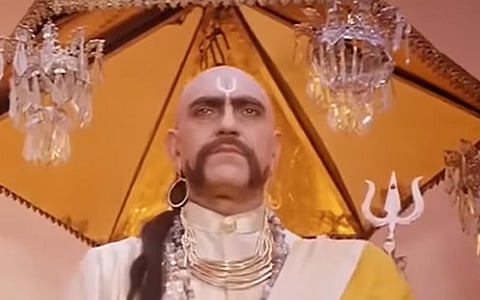
- Reviews
- Power List 2024
- Cannes 2024
- In-Depth Stories
- Web Stories
- News
- FC Lists
- Interviews
- Features
- FC SpecialsFC Specials

The one time I remember seeing a positive representation of a godman in popular film-media, it was the absurd MSG: The Messenger (2015). Gurmeet Ram Rahim Singh, the controversial cult leader in-real-life convicted of murder, castration, and rape, was front and center in the film- he starred in it, and was credited as director, writer, editor, cinematographer, art director, and action director, not to forget music and lyrics. ('You are the Love Charger!')
In more serious, less self-absorbed cinema, the godman is often seen as a stock villain. This week, we have a double-feature of dhongi-babas, or conmen-godmen. Mahesh Bhatt's Sadak 2 and Prakash Jha's Aashram, both releasing on August 28, the former on Disney+Hotstar and the latter on MX Player.
In Sadak 2 we have Makarand Deshpande who plays the cult-leader cloaked in black and dagger, the "fake-guru" that Alia Bhatt's character seeks revenge on. In Aashram it is the whimper-toned Bobby Deol playing Baba Nirala, a less obvious evil character, but one allegedly involved in the disappearance and murder of young women, a nod to Ram Rahim Singh.
Both have received flak for many reasons, one of which is the invective against the godman, seen as figureheads of Hinduism by many. Though it must be noted that Prakash Jha made a statement to Scroll.in, "There is no discussion of Hinduism, Hindu gods, or Hindu rituals in the show."
But this isn't the first time we have seen vitriol against the negative representation of a godman. Godman, a Tamil Zee5 production that was supposed to release on June 12 was dropped entirely because of the hubbub on social media about its representation of the saffron clad godman and brahmins as sexual, and predatory. The show's producer, Elango, and its director Babu Yogeswaran were charged under several IPC sections based on a complaint filed on behalf of 'World Brahmins Welfare Association'.
It was only time this vitriol came to boil. If one looks at the godman figure in cinema, they have mostly been seen as a negative character, a conniving capitalist. Amole Gupte's pristine white clad villainy in Singham 2, or Fahadh Faasil as the suit clad pastor in Trance, or Pankaj Tripathi, wig in place, in Sacred Games Season 2, or Mithun Chakraborty's hard-nod at Sri Sri Ravi Shankar in the 2014 sleeper hit OMG- Oh My God! Saurabh Shukla's portrayal of Tapasvi Maharaj, the Islamophobic godman in PK is another example. In the last three cases, there was some grumbling on social media against the 'Hinduphobic lens', but little else beyond.
It's become a villain trope that is understandable perhaps given the negative publicity around real life godmen- Baba Ramdev's sham empire, Jaggi Vasudev's allegations of land grabs, Nithyanand's cases of fraud and rape, and Radhe Ma's exaggerated speeches. But some caution needs to be taken before this villain trope sticks wholesale. It is a convenient way to dismiss the faithful, and an easy villain against the rational and burly hero, when there is one.
This is perhaps why no hue and cry was made when Singham 2 made the godman a villain, for Ajay Devgn's heroism blinded all. In films like Sadak 2 where it is Alia Bhatt who is unmasking the criminal, or Aashram where the hero is playing the villain, the villainy is glaring, and the invective more piercing.
But this isn't a new phenomenon. Jaadugar the 1989 film by Prakash Mehra begins with the gem encrusted footwear of the swamiji, to which puja is done, backgrounded by white devotees all wearing saffron robes and rudraksha malas. We finally see Amrish Puri as Mahaprabhu Jagatsagar Chintamani, a handlebar mustache, cloaked in gold-silk, adorned in gold, with the trishul jutting out of his left shoulder. He can configure dry dates, fresh flowers, and silver from the air. Needless to say, he's a fraud, and a jailbird. (In one quite hilarious scene when Amitabh Bachchan is trying to expose him by asking him for a child, Puri materializes a rather small brown banana and tells him to feed this to his wife, and Bachchan to outsmart him materializes from his sleeves a longer, whiter banana.) It's as comical as it is villainous. But of course since the 90s the demographic fear among Hindus has only become fiercer, and sometimes, fictive. Therefore the pushback against such films too is fiercer, and sometimes, fatuous.
It is important to call out stereotypes made for narrative contrivances. In a world that is increasingly insular, the last thing we need are stock characters of good and evil. Have you not heard, it's the age of the grey.